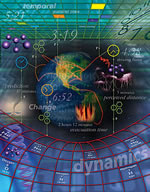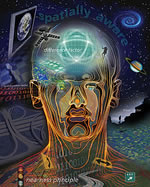ArcNews Technology and Trends Series
Thought leaders discuss changes and insights in the evolving landscape of GIS and IT technologies.

Illustration from Changing the Face of Geography, Spring 2009.
Geospatial Technology and the Future of the City
By Jack Dangermond, Esri President, Winter 2014/2015
An Alternative Approach to Geospatial Graduate Education
By Suzanne Perlitsh Wechsler, Associate Professor, Department of Geography, California State University, Long Beach (CSULB), Fall 2014
Train the Trainer
By John Schaeffer, GISP, and Karen Beardsley, PhD, GISP, Summer 2014
Redesigning Geospatial Education
By Anthony C. Robinson, Lead Faculty for Online Geospatial Education, Pennsylvania State University, Spring 2014
The Relevance of Cartography
By University Professor Dr. Georg Gartner, President, International Cartographic Association, Winter 2013/2014
Geodesign Education Takes Flight and
Confluence of Trends and Issues Actuates a Path for Geodesign Education
By Kelleann Foster, Associate Professor, Landscape Architecture, Penn State University, Fall 2013
Beginnings of Geodesign: A Personal Historical Perspective
By Carl Steinitz, Summer 2013
Agents, Models, and Geodesign
By Michael Batty, Bartlett Professor, University College London, Spring 2013
U-Spatial: A Consortium for the Spatial University
By Francis Harvey, Len Kne, and Steven Manson, University of Minnesota, Winter 2012/2013
Place-Based Knowledge in the Digital Age
By Thomas Fisher, Professor of Architecture and Dean of the College of Design, University of Minnesota, Fall 2012
Strengthening the GIS Profession
By David DiBiase, Director of Education, Industry Solutions, Esri, Summer 2012
Quo Vadimus?
By Brian J. L. Berry, University of Texas, Dallas, Spring 2012
Through the Macroscope: Geography's View of the World
By Jerome E. Dobson, Professor of Geography, University of Kansas, Winter 2011/2012
 Ecosystem Services—Learning to Leverage Natural Capital
Ecosystem Services—Learning to Leverage Natural Capital
By Frederick Steiner, Dean, School of Architecture, The University of Texas at Austin, Fall 2011
Hand in Hand—Spatial Information for Latin America
By Santiago Borrero, Secretary General, Pan American Institute of Geography and History, Summer 2011
On Scale and Complexity and the Need for Spatial Analysis
By Carl Steinitz, Wiley Professor of Landscape Architecture and Planning Emeritus, Graduate School of Design, Harvard University, Spring 2011
Integrated Models and Grand Challenges
By Michael Batty, Centre for Advanced Spatial Analysis, University College London, Winter 2010/2011
 Getting to Know the Mapping Sciences Committee
Getting to Know the Mapping Sciences Committee
By Keith Clarke, Chair, Mapping Sciences Committee, the National Research Council, Fall 2010
Geospatial Responses to Disasters: The Role of Cyberspace
By Melinda Laituri, Summer 2010
Building INSPIRE: The Spatial Data Infrastructure for Europe
By Max Craglia, Spring 2010
Kingston University London: 20 Years of GIS Education
By Kenneth Field, Winter 2009/2010
Governance of the NSDI
by Will Craig, Fall 2009
Process Models and Next-Generation Geographic Information Technology
by Paul M. Torrens, Summer 2009

Changing the Face of Geography: GIS and the IGU
by Roger F. Tomlinson, Spring 2009
Transport 2.0: Meeting Grand Challenges with GIScience
by Harvey J. Miller, Winter 2008/2009
Implementing Geographic Information Technologies Ethically
by Harlan J. Onsrud, Fall 2008
Dynamics GIS: Recognizing the Dynamic Nature of Reality
by May Yuan, Spring 2008
What Holds Us Together
by Arthur Getis, Winter 2007/2008
Living Inside Networks of Knowledge
by Nick Chrisman, Fall 2007

What Historians Want from GIS
by J.B. "Jack" Owens, Summer 2007
Bring Back Geography!
by Jerome E. Dobson, Spring 2007
Exploration in the Age of Digital Earth
by Dawn J. Wright, Winter 2006/2007
The Fourth R? Rethinking GIS Education
by Michael F. Goodchild, Fall 2006
Defining the Components of the Geospatial Workforce—Who Are We?
By Dr. Duane F. Marble, Castlereagh Enterprises, Inc., Winter 2005/2006